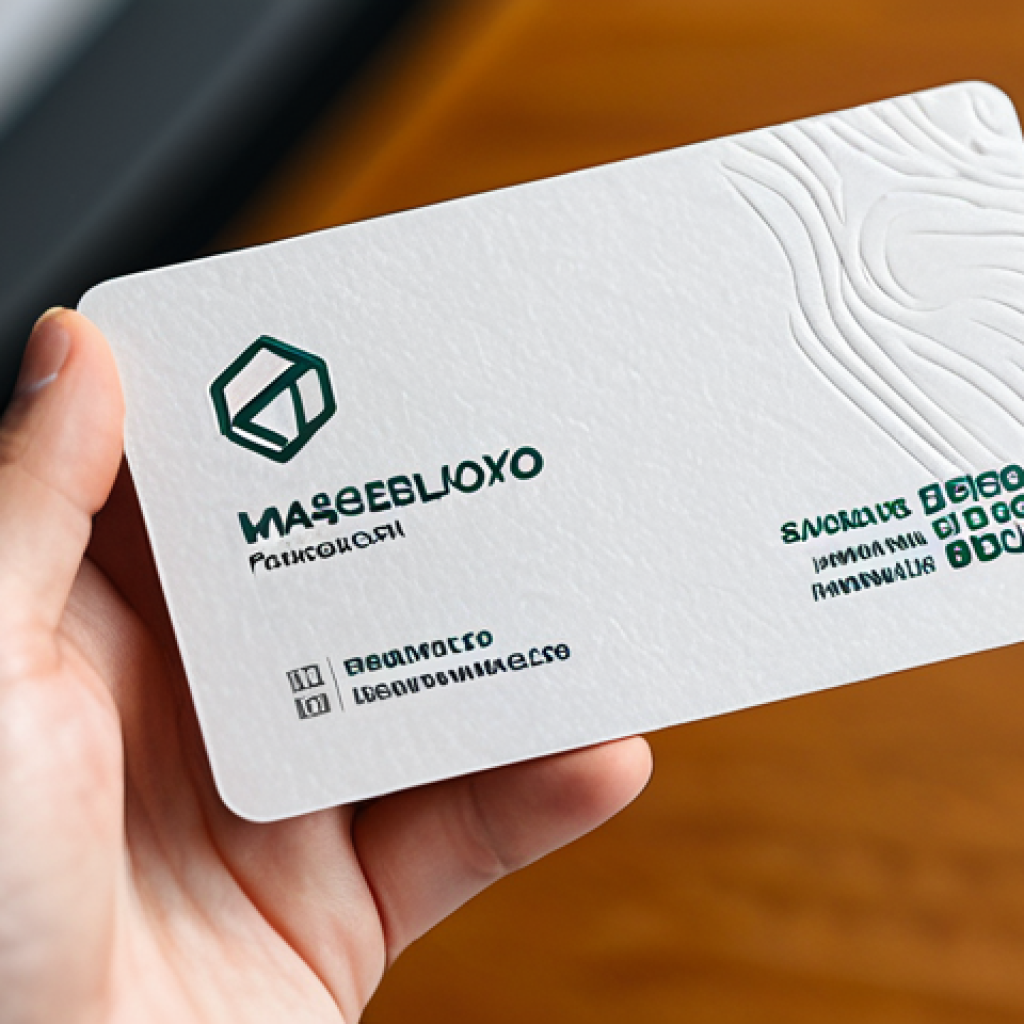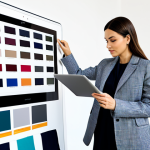Remember that palpable moment you swap business cards? For a fashion coordinator, it’s never just about contact details; it’s a profound, silent handshake, a miniature canvas screaming your unique aesthetic.
From my own personal experience, attending countless industry events, I’ve seen firsthand how a truly exceptional card—not merely well-designed, but one that subtly hints at a coordinator’s distinct flair or commitment to sustainable practices—leaves an unforgettable impression.
In today’s dizzying, hyper-digital fashion world, where trends explode and fade in an instant, you might wonder if a physical card still holds weight.
Yet, what I’ve observed is its enduring power, especially when it intelligently bridges the tangible with the virtual, perhaps featuring a sleek QR code linking directly to an immersive digital portfolio or even incorporating cutting-edge materials.
This isn’t just about exchanging information; it’s about crafting that critical first impression, signaling your expertise and unique vision in a brutally competitive landscape.
Let’s get into the specifics.
Beyond a Name: The Psychology of a Powerful First Impression

It’s fascinating, isn’t it, how a simple piece of cardstock can embody so much more than contact information? From countless industry mixers and high-stakes pitches I’ve attended, I’ve genuinely come to understand that a business card isn’t just a formality; it’s a psychological anchor.
When I hand over my card, I’m not merely offering my email; I’m extending a tangible piece of my brand, a physical representation of my artistic vision and professional commitment.
The sheer act of a carefully chosen paper stock, the weight of it in someone’s hand, the precise alignment of text—these elements subtly convey meticulousness, attention to detail, and a deep respect for one’s craft.
I remember vividly a time when I received a card from a fellow coordinator at a major fashion week event; it was minimalist, yet the texture was so unique and the ink so subtly raised that it immediately communicated an understated elegance and an innovative spirit.
That card didn’t just tell me *who* she was; it told me *how* she approached her work – with thoughtful precision and a quiet confidence. This initial sensory engagement can bypass the logical brain and tap directly into an emotional connection, fostering an almost immediate sense of credibility and intrigue before a single word is even spoken.
It truly shapes the perception of your brand’s essence long before a website is visited or a portfolio is opened. This profound, often unconscious, exchange is precisely why the physical card retains its irreplaceable value in a world saturated with fleeting digital interactions.
The Subtleties of Tactile Engagement
When you think about the last time you truly *felt* a business card, what stood out? For me, it’s always the unexpected textures or the robust weight that leave a lasting memory.
I’ve found that the tactile experience of a business card is profoundly underrated, yet incredibly impactful. Imagine handing someone a card made from recycled denim fiber – suddenly, you’re not just a fashion coordinator, you’re a *sustainable* fashion coordinator, without having to say a word.
This physical interaction creates a multi-sensory memory that digital exchanges simply cannot replicate. It’s about grounding your digital presence in something real and memorable.
I’ve personally experimented with various finishes, from soft-touch laminate that feels like velvet to a rough, uncoated stock that evokes an organic, artisanal feel, and the reactions are consistently immediate and often vocal.
People *notice* the quality, and that instantly translates to a perceived quality of your work. This level of detail communicates a professional who cares about every facet of their presentation.
Visual Cues and Brand Storytelling
Beyond touch, the visual narrative your card tells is paramount. It’s not just about a pretty design; it’s about a cohesive visual language that speaks volumes about your aesthetic.
My own journey in fashion coordination has taught me that your card should be a miniature mood board for your personal brand. Is your style avant-garde and daring?
Then perhaps bold typography and unexpected color combinations are in order. Are you known for classic, timeless elegance? A refined, minimalist design with a sophisticated font might be your signature.
I’ve seen cards that use abstract patterns reflecting a designer’s textile work or subtle debossed logos that hint at luxurious craftsmanship. It’s about translating your unique vision into a compact, impactful format.
The choice of color palette, the balance of negative space, and even the size and shape of the card itself contribute to this silent narrative, preparing your prospective client or collaborator for the visual journey your work will take them on.
This is where your expertise as a coordinator truly shines through, demonstrating your innate ability to curate and present.
Crafting Your Narrative: Aesthetic Cohesion and Brand Storytelling
In a field as visually driven as fashion, your business card isn’t just an accessory; it’s a pivotal extension of your professional identity. I’ve always viewed it as a micro-portfolio, a carefully curated snapshot of my brand’s essence.
My own experience has taught me that the most effective cards aren’t just pretty; they tell a story, your story, through their aesthetic choices. It’s about creating an immediate, intuitive connection between the card and the perception of your work.
For a fashion coordinator, this means every element, from the typeface to the finish, should echo the style you cultivate for your clients or the collections you bring to life.
Imagine a card for a coordinator specializing in vintage looks: perhaps it uses a faded, sepia-toned palette, a classic serif font, and a touch of linen texture, immediately evoking nostalgia and authenticity.
Conversely, a coordinator known for futuristic, experimental styles might opt for metallic accents, geometric patterns, and a sleek, transparent material.
The goal is to make someone look at your card and instantly *feel* your unique aesthetic, to glimpse the soul of your brand before they even click on your portfolio link.
This intentionality in design builds trust and sets expectations, signaling your expertise and unique approach right from the outset. It’s about making your card an authentic promise of what your professional service will deliver.
Visual Elements and Your Personal Brand
Every design choice on your business card is a silent declaration of your brand. When I was first starting out, I made the mistake of thinking ‘just get something printed.’ But I quickly learned, through trial and error at numerous industry events, that the visual elements are incredibly potent.
Consider these critical aspects:
- Color Palette: Does it align with your signature style? A soft, muted palette for bespoke bridal wear versus vibrant, bold colors for streetwear coordination. I’ve found that consistency across your brand assets – website, social media, and business card – reinforces recognition.
- Typography: Fonts convey personality. A sleek sans-serif for a minimalist aesthetic, an elegant script for luxury brands, or a quirky hand-drawn font for an indie, unconventional vibe. My advice is to choose fonts that are not only legible but also encapsulate the spirit of your work.
- Logo and Imagery: Your logo should be memorable and scalable. If you incorporate imagery, ensure it’s relevant and high-quality. A subtle pattern inspired by a textile print or a stylized illustration of a fashion element can add depth and intrigue without cluttering the card.
Consistency Across Platforms
One of the most valuable lessons I’ve learned in building my personal brand is the importance of seamless consistency across all touchpoints. Your business card should not exist in a vacuum; it needs to be a physical manifestation of your digital presence.
When someone receives your card, the transition from holding that tangible object to visiting your website or social media profiles should feel utterly seamless.
This means using the same brand colors, typography, logo, and overall aesthetic across your card, your online portfolio, your social media banners, and even your email signature.
This visual cohesion builds a strong, recognizable brand identity that resonates with your audience. I recall a client once telling me how impressed she was that my card looked “exactly like my Instagram feed,” and it instantly built a layer of trust and professionalism.
This consistency tells your audience that you are meticulous, organized, and have a clear, unified vision for your brand. It’s about reinforcing your professional identity at every turn.
The Tactile Experience: Materiality and Sensory Impact
The journey of discovering the perfect material for my own business cards was an eye-opener. I remember experimenting with everything from ultra-thick, multi-layered cardstock to recycled paper infused with wildflower seeds.
What I consistently found, and what resonated most deeply with those I exchanged cards with, was the profound impact of the *feel* of the card. This isn’t just about premium paper; it’s about how the chosen material communicates your values and your unique approach to fashion coordination.
A rough, textured card might suggest an earthy, organic aesthetic, perhaps for a coordinator specializing in sustainable fashion. Conversely, a sleek, smooth card with a metallic sheen could hint at a high-fashion, avant-garde style.
The weight of the card, the way it flexes, even the subtle scent it might carry (though that’s a more advanced, niche choice!)—these sensory details are absorbed by the recipient on an almost subconscious level.
They create a memory that is distinct from merely reading information off a screen. I’ve seen countless times how a unique material choice sparks curiosity and conversation, turning a simple exchange into a memorable interaction.
It’s about leveraging the physical world to make an emotional connection, ensuring your brand stands out in a crowded market simply by the way it feels in someone’s hand.
This tangible interaction is a powerful, often overlooked, layer in building lasting professional relationships.
Innovative Material Choices and Their Messages
When it comes to materials, the options are far more diverse than traditional glossy or matte cardstock. My own exploration has led me to some truly fascinating choices, each sending a distinct message:
- Recycled and Sustainable Papers: For the eco-conscious coordinator, choosing paper made from post-consumer waste, cotton, or even bamboo sends a powerful message about your commitment to sustainability. I’ve personally used cards made from repurposed coffee cups, and the conversations they sparked were always insightful, immediately positioning me as someone who values ethical practices.
- Unusual Textures: Think beyond smooth. Wood veneer, cork, metal, even transparent or frosted plastic can create an unforgettable tactile experience. A fashion coordinator specializing in edgy, industrial looks might find a metal card perfectly aligned with their aesthetic, while someone focusing on luxury textiles might opt for a soft, fabric-like paper.
- Specialty Finishes: Beyond the material itself, consider finishes like letterpress for a classic, debossed look, or spot UV for a modern, glossy accent on specific elements. I once received a card with a subtle holographic foil detail that perfectly encapsulated the cutting-edge style of the designer; it was a small detail that made a huge statement.
The Psychology of Weight and Durability
It might seem minor, but the weight and perceived durability of your business card play a surprisingly significant role in how your brand is perceived.
A flimsy, thin card can inadvertently communicate a lack of substance or attention to detail, even if your work is exceptional. Conversely, a thick, substantial card—often 18pt or higher—feels weighty, authoritative, and luxurious in the hand.
I’ve noticed that people tend to hold onto thicker cards longer; they feel more premium, less disposable. It’s an unspoken message about the value you place on your own brand and, by extension, the value you will bring to your clients.
A durable card also implies longevity, suggesting a professional relationship built to last. This subconscious association between physical robustness and professional reliability is something I’ve leveraged time and again to great effect in my networking efforts.
It’s about making a statement of enduring quality without uttering a single word.
Bridging Worlds: Integrating Digital Innovation with Tangible Design
In our increasingly interconnected world, the physical business card isn’t just a relic; it’s a powerful bridge between the tangible and the digital. From my vantage point, attending countless tech-infused fashion shows and digital conferences, I’ve seen how integrating digital innovation into a physical card transforms it from a mere contact exchange into an immersive experience.
The true genius lies in not replacing the physical, but augmenting it. Imagine a card with a sleek QR code that, when scanned, doesn’t just link to a static website, but plays a short, dynamic video showcasing your recent coordination projects, or directly opens a personalized mood board on your digital portfolio.
I remember when I first started incorporating a custom QR code that linked directly to my latest Instagram reel of a styling session; the immediate engagement was palpable, turning a simple card swap into an instant, interactive demonstration of my capabilities.
This approach is about leveraging the enduring human preference for physical interaction while simultaneously tapping into the efficiency and richness of digital content.
It’s about demonstrating your forward-thinking mindset and your ability to navigate both traditional and contemporary realms of the fashion industry, solidifying your image as a modern, adaptable coordinator.
Leveraging QR Codes and NFC Technology
The simplest yet most effective digital integration I’ve personally used is the QR code. But don’t just link to your homepage; think strategically about where you want to direct your audience:
- Dynamic Portfolios: Instead of a static link, use a QR code that updates to your *latest* collection or project. I’ve found this keeps my card relevant long after printing.
- Video Introductions: A short, compelling video showcasing your personality and work ethos can be incredibly powerful. It adds a human touch that text alone cannot convey.
- Direct Scheduling: For busy coordinators like myself, a QR code that links directly to a calendly or booking page can streamline the initial consultation process, making it incredibly convenient for potential clients.
- Social Media Deep Links: Directly to your most active or relevant social media platform, bypassing the need for manual searches.
Beyond QR codes, consider Near Field Communication (NFC) chips embedded directly into the card. While slightly more expensive, an NFC-enabled card allows someone to simply tap their smartphone against it to instantly access your digital assets. I’ve witnessed the ‘wow’ factor this creates; it positions you as a tech-savvy professional who is truly ahead of the curve.
Building an Interactive Digital Ecosystem
The physical card is the gateway, but your digital ecosystem is where the real engagement happens. My experience has taught me that the goal isn’t just to transfer information, but to invite someone into your world.
This means ensuring that whatever digital destination your card leads to—be it a website, an online portfolio, or a social media profile—is robust, well-maintained, and reflective of your brand.
| Digital Integration Feature | Benefit for Fashion Coordinator | Impact on Card Recipient |
|---|---|---|
| Dynamic QR Code to Portfolio | Showcases latest work, demonstrates adaptability. | Instant access to updated, relevant visual content. |
| NFC Chip for Contact Info & Video | High-tech impression, quick information transfer. | Effortless access, memorable interactive experience. |
| Link to Curated Mood Boards | Highlights aesthetic vision and conceptual skills. | Deeper understanding of coordinator’s creative process. |
| Integration with Calendly/Booking System | Streamlines lead generation, reduces friction. | Convenient scheduling of initial consultations. |
| Direct Link to Specific Social Post | Drives engagement to specific campaigns or collaborations. | Follows up on specific industry trends or events. |
This holistic approach ensures that your initial physical impression is seamlessly followed by a rich, engaging digital experience, solidifying your expertise and making your brand truly unforgettable.
It’s about creating a comprehensive narrative that lives both in hand and online.
Sustainability in Your Signature: Ethical Choices for Impact
As a fashion coordinator, I’ve seen firsthand the industry’s increasing push towards ethical and sustainable practices. It’s no longer just a trend; it’s a fundamental shift in values, and your business card is a perfect, subtle opportunity to reflect your commitment to this movement.
From my personal journey, actively seeking out and utilizing sustainable materials for my own brand’s collateral has been incredibly rewarding. It’s not just about feeling good; it’s about making a quiet yet profound statement about your professional ethos.
When I hand someone a card made from recycled cotton or embedded with seed paper, it often sparks a conversation about ethical sourcing, responsible consumption, and my own dedication to a more sustainable future in fashion.
This immediately positions me not just as a coordinator, but as a conscientious industry leader. It speaks volumes about your awareness of global issues and your dedication to integrating those values into every facet of your work, including the very first physical representation of your brand.
In a competitive landscape, differentiating yourself through genuine, demonstrable values can be a significant advantage, attracting like-minded clients and collaborators who prioritize ethical considerations as much as aesthetics.
Eco-Friendly Materials and Their Origin Stories
Choosing sustainable materials for your business card tells a compelling story before you even utter a word. Here are options I’ve explored and found impactful:
- Recycled Content Paper: The most common and accessible option. Look for high post-consumer waste (PCW) content. I’ve used cards made from recycled denim and felt a genuine connection with the material’s past life.
- Seed Paper: These cards are embedded with flower or herb seeds and can be planted after use. I’ve personally given out seed paper cards, and the joy people express when realizing they can *grow* something from my card is unparalleled. It’s a living, breathing testament to sustainability.
- Alternative Fibers: Papers made from bamboo, hemp, cotton linters (a byproduct of textile production), or even reclaimed agricultural waste offer unique textures and reduce reliance on virgin wood pulp. I once used a card made from sugar cane residue, and its unique feel was a great conversation starter.
Communicating Your Ethical Stance
It’s not enough to simply *use* sustainable materials; you need to subtly communicate it. My personal approach involves a small, elegant icon or a concise statement on the back of the card, something like “Printed on 100% Recycled Post-Consumer Waste Paper” or “Plant Me!
Made with Seed Paper.” This isn’t about being preachy; it’s about being transparent and proud of your choices. This small detail can resonate deeply with clients who prioritize ethical sourcing and environmental responsibility in their own businesses.
It aligns your brand with a broader, more conscious movement, establishing shared values and fostering a deeper connection. In a world where consumers and businesses are increasingly scrutinizing supply chains and environmental impact, demonstrating your commitment through your business card can be a powerful differentiator, signaling your expertise and trustworthiness in navigating the complex ethical landscape of the fashion industry.
Networking Beyond Exchange: Follow-Up and Relationship Building
Handing over a business card is merely the first step; the true magic lies in the follow-up, transforming a fleeting introduction into a lasting professional relationship.
My career as a fashion coordinator has taught me that the card itself is an invitation, a tangible prompt for future engagement. I’ve personally found that the most successful networking isn’t about collecting the most cards, but about cultivating genuine connections with the ones you do collect.
The moment someone holds your card, they’re holding a potential future collaboration, a valuable resource, or a new client. This initial impression must be backed by a strategic follow-up plan that converts interest into action.
It’s about leveraging the impression your card made to initiate meaningful dialogue, whether through a personalized email, a thoughtful LinkedIn connection, or even a direct message referencing something specific from your conversation.
The card serves as that crucial memory trigger, a physical reminder of your encounter, making your follow-up feel less like a cold call and more like a continuation of an already established connection.
This disciplined approach to nurturing relationships is where true professional growth and significant opportunities often emerge.
Strategic Follow-Up Tactics
Once the card has been exchanged, the real work begins. I always recommend a multi-pronged approach to follow-up, tailored to the specific interaction:
- Personalized Email: Within 24-48 hours, send a brief, personalized email referencing something specific you discussed. I always jot down a quick note on the back of the card I receive to remember details. For instance, “Great chatting about the future of sustainable denim at the conference yesterday!”
- LinkedIn Connection: A professional and non-intrusive way to stay connected. Include a brief personalized message here too.
- Value-Added Content: If relevant, share a piece of content that might be valuable to them – an article, a resource, or even a mood board related to your discussion. This demonstrates your expertise and generosity.
- Remembering Key Details: My experience has shown that remembering a unique detail – a shared interest, a project they mentioned, or even a favorite designer – makes your follow-up feel incredibly personal and authentic, setting you apart from generic mass outreach.
Long-Term Relationship Nurturing
Building a network isn’t a one-time event; it’s an ongoing process of nurturing. Your business card initiated the contact, but sustained effort builds the relationship.
I’ve cultivated many long-term collaborations and friendships by consistently staying in touch, offering support, or sharing relevant industry insights without expecting anything in return.
This could involve:
- Occasional check-ins to see how their projects are progressing.
- Sharing articles or news that you think they would find interesting.
- Connecting them with others in your network if there’s a mutual benefit.
- Remembering important dates or milestones in their career or business.
This approach transforms your business card from a mere piece of paper into the cornerstone of a vibrant, supportive professional ecosystem. It emphasizes that you are not just a service provider, but a valuable peer and potential partner in the dynamic world of fashion.
Analyzing Your Impact: Metrics and Continuous Evolution
Even a seemingly simple tool like a business card can, and should, be subject to a form of analysis and continuous improvement, much like any aspect of a professional brand.
From my perspective, having been involved in countless projects from initial concept to final execution, I’ve learned that everything can be optimized.
While you can’t install Google Analytics on a piece of cardstock, you can certainly observe its effectiveness and adapt. I’ve personally paid attention to the feedback I receive, the rate at which I get follow-ups after distributing cards, and even the type of conversations the card itself sparks.
Does the design consistently elicit comments? Does the QR code get scanned frequently? These are qualitative “metrics” that, when observed over time, provide invaluable insights.
This isn’t about rigid data points, but about an intuitive understanding of what resonates and what falls flat. It’s about being an agile professional, always ready to refine and evolve your brand’s physical representation to maximize its impact and ensure it remains a potent tool in your networking arsenal.
This iterative process is a hallmark of true expertise, ensuring that your tools, including your business card, are always performing at their peak.
Qualitative Feedback and Observation
Direct metrics for a business card are challenging, but qualitative observation provides a rich tapestry of insights. I always pay close attention to the immediate reactions and subsequent behaviors of people I hand my card to:
- Verbal Feedback: Do people comment on the design, the material, or the unique features (like a QR code)? A simple “Wow, this feels great!” or “What a cool QR code!” is a strong indicator of effectiveness.
- Handling: Do they casually slip it into a pocket, or do they pause, examine it, and perhaps even show it to someone else? The latter indicates a stronger initial impression.
- Conversation Starters: Does the card itself spark a discussion about your brand, your values (e.g., sustainability), or your digital presence? This is a prime indicator that it’s working as a conversation piece, not just an information carrier.
These observations, gathered over time, inform my decisions for future card designs or adjustments. It’s about learning from every interaction and using those insights to refine your brand’s physical footprint.
Iterative Design and Branding Evolution
Just as fashion trends evolve, so too should your personal brand, and by extension, your business card. My career has taught me that staying stagnant is the quickest way to become irrelevant. I don’t believe in a “one-and-done” approach to business cards. Instead, I view them as living representations of my evolving brand. This means:
- Periodic Updates: Every few years, or when I pivot my brand’s focus (e.g., from general fashion coordination to specializing in luxury bespoke events), I reassess my card design.
- Incorporating New Technologies: As new digital integration options emerge (e.g., enhanced augmented reality experiences via QR codes), I consider how they can be seamlessly woven into the card.
- Reflecting Growth: As your expertise deepens and your aesthetic matures, your card should reflect that elevated level of professionalism and artistry.
This iterative process ensures that your business card remains a powerful, current, and relevant tool, truly embodying your continuous growth as a fashion coordinator and solidifying your authority and trust within the industry.
It reflects a dynamic, forward-thinking approach to your professional identity.
Concluding Thoughts
The journey to mastering the art of networking and personal branding begins with understanding the profound impact of even the smallest details. Your business card, far from being a mere formality, stands as a potent, tactile extension of your professional identity.
It’s a silent yet powerful ambassador, communicating your aesthetic, your values, and your commitment to excellence long before words are exchanged. By thoughtfully curating its design, material, and integrated digital elements, you transform a simple piece of paper into a memorable experience, a psychological anchor that cements your first impression and sets the stage for enduring professional relationships.
Useful Information to Know
When seeking a designer for your business card, look for someone who deeply understands branding, not just graphic design. Platforms like Behance or a strong referral network can be great starting points, but always prioritize portfolios that showcase a nuanced grasp of brand identity and visual storytelling.
The cost of business cards varies widely, from budget-friendly online printers for a few dollars to premium custom designs and materials that can run into hundreds. Expect to invest more for unique textures, specialty printing techniques (like letterpress or foil), and lower quantity runs.
Beyond your name and basic contact details, consider including a concise tagline that encapsulates your unique value proposition. A dynamic QR code leading directly to your latest portfolio updates or a specific project is almost a non-negotiable in today’s interconnected digital landscape.
Avoid cluttering your card with too much information; less is often more, allowing for greater impact. Ensure your chosen font size is easily legible and that your design aligns cohesively and consistently with your overall brand aesthetic across all digital and physical platforms.
Always present your card with confidence and a brief, engaging introduction that complements its design. Keep your cards crisp and clean in a professional cardholder – a crumpled or worn card can inadvertently send a message about your attention to detail and professional standards.
Key Takeaways
Your business card is a strategic, multi-sensory brand asset, far more than just contact information. It’s a critical tool for creating powerful first impressions, communicating your brand story through tactile and visual cues, and seamlessly bridging your physical presence with your digital ecosystem.
Prioritizing thoughtful design, innovative materials, and a strategic follow-up approach ensures your card acts as a cornerstone for building lasting, valuable professional relationships and solidifies your unique position in the industry.
Frequently Asked Questions (FAQ) 📖
Q: In such a fast-paced, digital fashion world, how can a physical business card truly stand out and make a memorable impact today?
A: Oh, this is a question I get all the time, and it hits home because I’ve lived it. You’d think with Instagram and LinkedIn, a physical card is just, well, quaint, right?
But I’ve personally seen the opposite. The trick isn’t just having one, it’s making it an experience. Think about it: when I’m at a frantic fashion week event, someone hands me a flimsy, generic card – it vanishes into the abyss of my bag.
But then, someone hands me a card with a unique texture, maybe a subtle debossed logo that just feels expensive, or even a tiny, almost imperceptible scent.
Suddenly, it’s not just paper; it’s a tangible anchor. It’s that silent, unexpected moment of connection. It tells me, without a single word, “I pay attention to details.” And in fashion, details are everything.
It’s about creating a moment of pause, a sensory experience that digital just can’t replicate. It signals intentionality, which is gold in our industry.
Q: What specific design elements or materials have you seen make the most profound difference on a fashion coordinator’s business card?
A: From my vantage point, the “profound difference” isn’t necessarily about going overboard; it’s about intelligent choices that echo your personal brand.
I’ve been handed cards that were mini works of art – not just visually, but tactually. For a fashion coordinator, incorporating a material that hints at your aesthetic is brilliant.
Think recycled paper if sustainability is your jam, or a card with a subtle fabric-like texture if you’re all about textiles. I once received a card that felt like a thick, perfectly tailored suiting fabric – instantly, I knew that coordinator understood quality.
Beyond materials, the smart integration of technology, like a crisp, easily scannable QR code that actually links directly to an immersive digital portfolio or even a short, personalized video, can be a game-changer.
It shows you’re forward-thinking, not just stuck in the past. It’s about bridging the gap between that physical handshake and the expansive world of your digital work.
Q: Considering all the avenues for self-promotion, is investing in a high-quality, distinctive business card genuinely worth the expenditure for a fashion coordinator starting out or looking to elevate their career?
A: Absolutely, unequivocally, yes! And honestly, anyone who tells you otherwise probably hasn’t truly grasped the power of that initial, tangible touchpoint.
When I think back to early career struggles, every penny counted, but skimping on a card felt like cutting corners on my own image. It’s not just a fancy piece of paper; it’s often the very first physical representation of your brand and your professionalism.
In an industry as cutthroat as fashion, where everyone’s vying for attention, that little card is your personal ambassador. It screams, “I take myself seriously, and I invest in my craft.” A cheap, flimsy card, no matter how talented you are, can subconsciously convey a lack of attention to detail or even a perceived lack of success.
A high-quality card, conversely, suggests you’re established, you’re discerning, and you understand the nuances of presentation. It’s not an expense; it’s an investment in crafting that pivotal first impression that can open doors you didn’t even know existed.
It sets the tone before you’ve even spoken a word.
📚 References
Wikipedia Encyclopedia
구글 검색 결과
구글 검색 결과
구글 검색 결과
구글 검색 결과
구글 검색 결과





